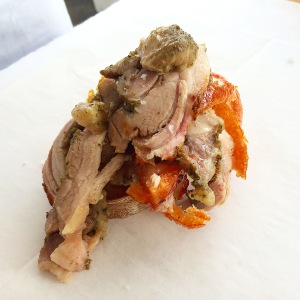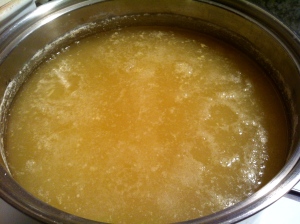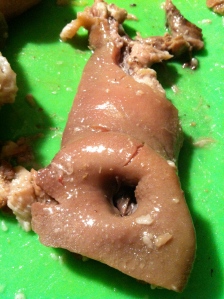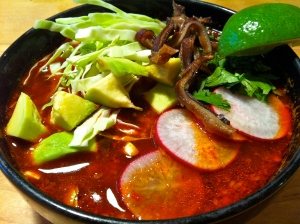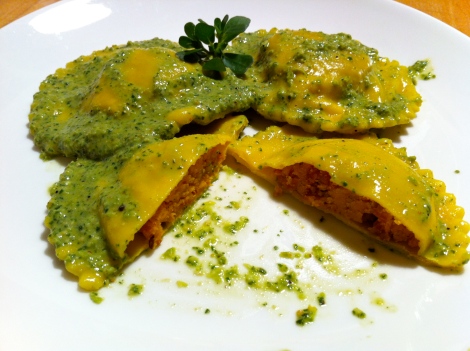Category Archives: Cooking
July 8, 2015 Shinsato Farm Rabbit
Local animal protein is starting to become more accessible to home cooks on Oahu. In addition to beef, pork, and chicken, you can now find local venison and rabbit. Ed Kenney started slinging pork and tasty porchetta sandwiches at the Kaka’ako Farmers’ Market a few months back to help Shinsato Farms move product and recently added rabbit to his offerings.
I jumped (or hopped) at the opportunity to play around with some bunny and talked with Ed about his experience working with wabbit at his westaurants. Through Ed’s input, the wonders of google, and my imagination, I managed to use the entire rabbit in three tasty meals.
Rabbit is extremely easy to butcher. It took just a few minutes to divide the skinned, headless carcass into neat, manageable pieces. I first separated the forelegs, then the rear, followed by chopping off the end of the spine and pelvis. Rabbit bones are easy to cut through and my 8” chef’s knife was sufficient. Next, I cut along the spine and separated the loin and saddle, leaving the ribs attached to the loin for aesthetics. I roasted the bones and made stock.
Following Ed’s advice, I made a white ragu with the forelegs. I went with my usual ragu base, but added sprigs of thyme and didn’t include tomato. In a bath of white wine and rabbit stock, I simmered the ragu for about 5 hours, then added fresh tagliatelle and topped with MA’O parsley and pecorino.
I wrapped the saddles in prosciutto, then browned them and the ribs in duck fat and finished to medium in the oven. I sautéed the liver and kidneys, keeping them pink in the center, and served everything over a fig/port puree and covered in jus.
The rabbit’s swansong came in the form of braised legs, another Chef Ed suggestion. I went coq au vin style and rendered lardons in Naked Cow Dairy truffle butter, browned and removed the legs, added and softened the mir poix, then dumped half a bottle of red, rabbit stock, and herbs, returned the rabbit, and braised for a couple hours. I put everything except for the rabbit in the vitamix, then thinned the sauce out with a little more stock. I hit the leg with my Searzall and served it, well-sauced, over Camas Country Mill heirloom polenta. For the polenta, I went 4:1 liquid to cornmeal, using half milk and half rabbit stock, and finished with an ungodly amount of butter and pecorino.
My rabbit adventure was a success. The meat itself was juicy, tender, and tasty. It did not taste like chicken. The 2.5-pound rabbit cost $30 and provided three meals for two people. If you’d like to try for yourself, visit Kaimuki Superette at the Kaka’ako Farmers Market on Saturdays from 8 a.m. to noon.
DISCLOSURE: I paid full price for everything.
- 1 comment
- Posted under Cooking, Hawai'i, Uncategorized
May 12, 2012 Pig Head Pozole
As Cinqo de Mayo approached there was a lot of talk about pozole. I couldn’t recall hearing about the pre-Columbian Mexican soup prior to this year and it captured my interest. There are several different versions of pozole, but the most intriguing was pozole rojo, made with hominy, chillies and, usually, pork. I didn’t make it to the Honolulu’s Cinqo de Mayo celebration to try Zaratez‘ take on pozole, but hit up Serg’s, a place near my house that makes some really good tacos. For Cindqo de Mayo they offered a pozole verde, which was greasy, salty, and a huge disappointment. It became clear to me that I would have to take matters into my own hands.
Mercado De La Raza is the only Mexican grocery that I know of on island and was naturally my first stop for ingredients. I picked up dried chilies, some really funky purple corn, and cal (calcium hydroxide). The total was only $4! I went to my usual purveyor of pig in Chinatown and picked up half of a head. The butcher lady was a little put off by my wanting an half of a head instead of my usual jowl. Her confusion and the language barrier led to me getting a boneless half head, but it didn’t end up affecting the outcome.
Pig Head Pozole:
pig head (1/2 head) *shave or burn off any hair
hominy (made from 1 lbs dried corn and cal)
dried chilies (4 hot, 4 medium)
onion (1)
garlic (8 cloves)
carrot (1)
celery (1 stalk)
pork stock (2 cups homemade frozen concentrate)
water
cumin
chili powder
salt
pepper
Garnish:
crispy pig ear
cilantro
radish
cabbage
avocado
lime
The party started with sautéing 1/2 of the onion in a big, heavy pot, then throwing in the carrot, celery, and a few cloves of garlic before adding the head, pork stock, and water. I added cumin, salt, and pepper, brought everything to a boil and let it simmer for about 5 hours, periodically skimming the surface.

Once everything was under control with the soup, I moved on to the hominy.
I filled another big, heavy pot with water, added the corn and the cal, and brought it to a boil. I let it simmer for about 3 hours, then shut off the heat and left it on the stove overnight.
After about 5 hours, I removed the soup from the heat, strained the liquid, pulled apart the head meat, then refrigerated both overnight.
The next day, I skimmed off the fat from the surface of the now congealed broth (which was surprisingly very little) and brought it back to a boil. Next, I chopped the gelatinous chunk of meat into manageable pieces and added them to the broth. I drained the corn and rinsed it several times to be sure to remove all traces of the cal, then added it to the soup.

Prior to cooking the head, I removed the ear and set it aside. At this time, I put the ear in a small pan with water and brought it to a boil. I dumped out the scummy water, replaced it with fresh water and returned the ear to a boil. I added cumin, chili powder, salt and pepper, then simmered the ear for about 2.5 hours. While this was going on, I toasted my chilies, then sauteed the other half onion and garlic in the fat I scraped off from the top of the broth. I removed the ear from the pan and used the liquid to rehydrate the chilies, which took about 30 minutes. I put the chillies, onion, and garlic into the food processor with a little of the rehydrating liquid and pulsed it into a paste.

I added the chili paste to the soup and let it simmer for a few hours. That was pretty much it for the soup. I cut the ear into thin strips, sprinkled them with sea salt and put them under the broiler. For garnish I went with the ear, avocado, radish, cabbage, cilantro, and lime.
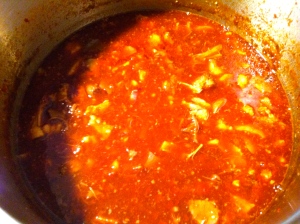
The slices of ear lost their crispiness once they met the broth and will not be including in future pozole endeavors. I also forget Mexican oregano when I was at the market and will be including it next time around. The broth was really good, full of porky richness and a nice amount of heat. The meat was tender, pieces of skin like butter, and the hominy very bean-like. There are relatively few ingredients involved and the only solids in the soup itself are pork and hominy. The garnishes provided interesting textures and, with the exception of the not-so-crispy crispy pig ear, everything in the bowl got along swimmingly. I’m my own harshest critic and was very pleased with the outcome. I have a new favorite soup!
- 4 comments
- Posted under Cooking, Hawai'i
January 16, 2012 Hawaiian Red Veal Tongue with MA’O Baby Root Vegetables

Last Saturday at the KCC farmers market, my friend Nanette let me know that Hawaiian Red Veal had brought some offal to sell, including two tongues. I’ve eaten tongue, but this would be my first time cooking it. MA’O Organic Farms had some baby root vegetables that looked like the perfect companion for the tongue.
Pinot Braised Hawaiian Red Veal Tongue:
Hawaiian Red Veal tongue (about 1.25 lbs)
guanciale (2 1/4″ slices from my home cured guanciale, cut into 1/4″ strips)
butter (2T for the guanciale, 1T for roux, 1T for mushrooms)
shallots (4, quartered, from Pit Farm)
carrots (1 purple, 1 yellow, from Pit Farm)
celery (1 stalk, from Pit Farm)
roma tomatoes (3, skinned and cored, from Ho Farms)
garlic (2 cloves, smashed)
thyme (3 sprigs)
bay leaves (2 from tree at my house)
wine (about 3 cups of pinot noir)
chicken stock (1-2 cups, homemade)
Hawaiian sea salt
black pepper
parsley (from my garden for garnish)
Small Kine Farm baby portabella mushrooms (handfull, halving the bigger ones)
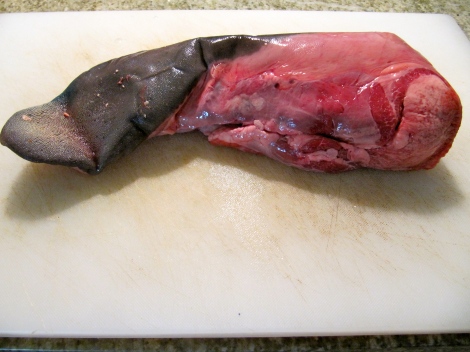
Once in the kitchen, the first thing I had to do was remove the skin from the tongue. I simmered the tongue in water for 1 hour

then removed the skin with a knife.
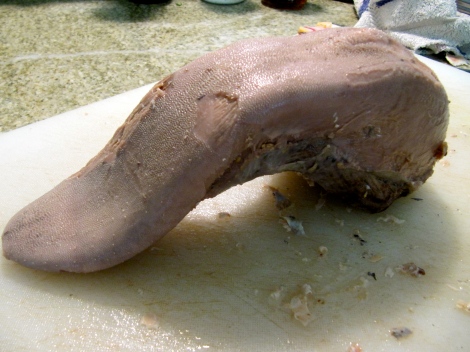
Next, I rendered the fat out of the guanciale in butter, then removed the guanciale.

I browned the lightly floured tongue in the guanciale fat/butter and set it aside. Next, I added shallot, carrot, and celery to the pan. When they were about ready, I added the garlic, then the tomato. I returned the tongue and the guanciale to the pan, then added the wine, chicken stock, thyme, and bay leaves and seasoned with salt and pepper.
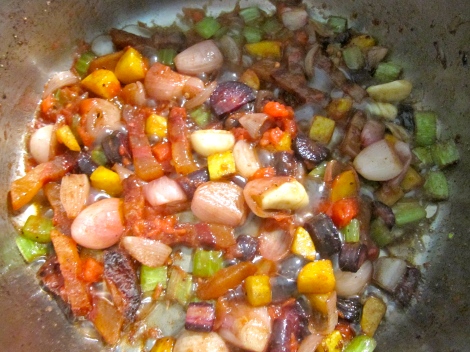
I let everything simmer on low heat for 4 hours, turning the tongue a couple times and making sure there was enough liquid in the pan. I removed the tongue and strained the braising liquid. I returned the liquid to a pan and added some roux to thicken it into a sauce. I sauteed some Small Kine Farm baby portabella mushrooms in butter, then added them to the sauce. I put the tongue in with the sauce and mushrooms and warmed it back up. For service, all I had to do was remove the tongue, slice it, plate it, top it with the sauce, and serve with the root vegetables.
Roasted MA’O baby root vegetables:
1 pound baby turnips, radishes, beets, carrots
thyme (3 sprigs)
rosemary (1 sprig)
Hawaiian sea salt
black pepper
extra virgin olive oil
I went with a simple roast for the root vegetables. I scrubbed them in the sink, removed the tops and bottoms, and tossed them in the olive oil, salt, pepper, thyme, and rosemary. They were ready to party after about 30 minutes in a 400 degree oven.
I was extremely satisfied with how the meal turned out. A knife was not required for the tongue, the sauce was very rich and flavorful, and the vegetables were crisp and delicious.
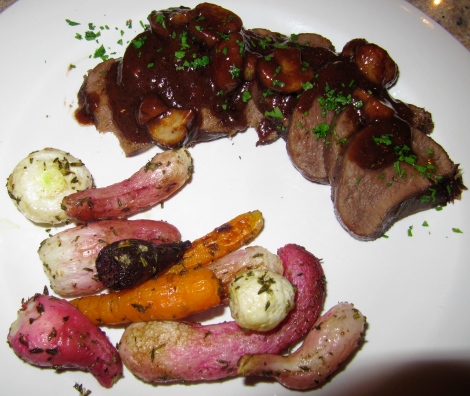
- Leave a comment
- Posted under Cooking, Hawai'i
January 3, 2012 Rib Eye Ragu
I enjoy pasta…a lot… I typically make pasta a couple times a week and usually sauce it with some sort of ragu. Hawai’i has come a long way in the past few years and I’m able to source most of the vegetables I use locally. Meat is another story. There is not a single butcher shop on Oahu. Finding local meat is no easy task. Unfortunately, I buy the majority of my meat from Safeway; more specifically, from the small section of soon to expire meat that is discounted 30-50 percent at the Manoa Safeway. I buy whatever is looking the best and the best value. Today there were some nice looking bone-in rib eyes and I took one home with me to make a ragu.
Rib Eye Ragu:
rib eye steak (1.25lbs, bone-in)
roma tomatoes (16 small/medium from Ho Farms)
onion (small from Pit Farm)
carrot (1 purple, 1 yellow from Pit Farm)
celery (1 stalk from Pit Farm)
garlic (2-3 cloves)
chili (2 Hawaiian chilis from pit Farm)
fresh herbs (minced rosemary, sage, basil, parsley and a bay leaf from garden)
wine (1/2 cup or so, i used prosecco that had gone flat)
olive oil
salt and pepper to taste
Cut the steak into chunks and brown them and the bone in olive oil. I like to get everything nice and brown. While browning the beef, I took care of the tomatoes. I cut a small x onto the bottom of each tomato, emerse them in boiling water until the skin begins to peel, then submerge them in an ice bath. Next, I remove the skin, seeds, and base of stem, then chop them up finely. Once the beef is browned to your liking, add the onions, carrot, and celery. I chop my mirepoix very finely, how you do it is up to you. Once the mirepoix is soft and looking ready, I add the garlic. The garlic cooks fast and I drop the herbs in just before the garlic is done. Once everything is ready, I deglaze the pan with wine, then add the tomatoes. I like heat and drop a couple chilis in to give the ragu a kick. This concludes the active cooking part of the sauce. All you have to do now is reduce the heat to low, stir occasionally, and add water if things get too dry. I usually simmer my sauces for 4+ hours, but was in a bit of a rush today and was only able to simmer for a little over 2 hours. It was long enough for the meat to become fork tender and that’s all you really need. I removed the bone, the chilies, and the bay leaf, pulled apart the steak, and made sure the ragu was properly seasoned. Since I made ravioli the day before, I went with quick and easy hand cut pasta to go with the ragu.
Pasta
00 flour (about 3 cups)
eggs (3 local eggs)
olive oil (splash)
water (splash)
salt (pinch)
I put 1 cup of flour, the eggs, salt, and the olive oil into my kitchenaid stand mixer and blend well, then add the rest of the flour. Add flour or water until proper consistency is achieved. The dough should no longer be sticky, but not be dry enough to fall into a bunch of little pieces. Once the dough is looking good, I let the mixer do its magic for 10 minutes, then wrap the dough in plastic, and allow it to rest for at least 30 minutes. I run the dough through my manual pasta machine and stop at number 6 or 7 depending on which type of pasta I’m making. My machine starts at 0 and the highest number (thinnest pasta) is 9. Since I was going with a rich, heavy sauce, I went for a thicker pasta to absorb the goodness. Once the pasta is rolled to the desired thickness, I flour both sides, fold it over itself a couple times, and cut it with a knife. I usually do strips a little under a half inch wide. My personal preference is for wider, thicker noodles. After the noodles are cut, I unfold them and toss them on a floured surface. It only takes a few minutes for the pasta to cook. Once the pasta was cooked, I tossed it with the ragu, and topped with freshly grated pecorino.
The outcome: I make a lot of ragus and a lot of pasta, so I’ve had plenty of practice. The practice pays off and I had another delicious meal. The rib eye ragu really tasted like rib eye and was quite good. The pasta was its normal, wonderful self.
- Leave a comment
- Posted under Cooking, Hawai'i
January 2, 2012 Sausage and Kabocha Ravioli in Purslane Pesto
It looks like I won’t be doing any traveling until my financial situation drastically improves. In the meantime this blog will be based on things I do at home in Hawaii. One of those things is cooking and I’m going to start sharing what I make and how I make it. I apologize for the lack of pictures and will try to start taking some action shots in the future.
Last Saturday I picked up 1/2 a kabocha pumpkin from my favorite vendor at the farmers market, Pit Farm. I’ve made kabocha ravioli in the past and decided to do something other than tossing it in a brown butter sage sauce this time. One of my pantry items at home is Kukui Italian Sausage. While I would prefer to make my own, Kukui is locally made and good enough for me. I use it a lot for all kinds of different stuff and it’s handy to have on hand. I thought that adding sausage to the filling would compliment the pumpkin well.
While at the farmers market, I also picked up some purslane from Otsuji Farm, without knowing what I would do with it. My only encounters with purslane have come in salad form and I decided to see how it would work in a pesto. When I went to Whole Foods to pick up pine nuts, they were sampling a deliciously creamy goat cheese, le picandou, that found its way into the pesto. Meyer lemons are currently going off on Oahu and my roommate obtained a big bag of them from a friend’s tree.
Needless to say, I got my hands on some pretty great ingredients. My only goal was not to mess them up!
Ravioli dough:
00 Flour (around 3 cups)
3 Eggs (local of course)
Kabocha (about 1/2 cup roasted and mashed)
salt (pinch)
extra virgin olive oil (little splash)
For the dough, I mix everything in my Kitchenaid stand mixer. I add more flour or olive oil depending on the consistency of the dough until it is no longer sticky, but not quite falling apart into a bunch of small pieces. Once the desired consistency is reached, I let the machine work the dough for about 10 minutes, wrap the dough in plastic and let it rest for about an hour. I incorporated a little kabocha to get some extra pumpkin-ness and brighten the color of the pasta.
Ravioli filling:
Kabocha (1/2 of a kabocha, but didn’t use all)
Sausage (8oz Kukui Italian Sausage)
Sage (a dozen or so leaves from my garden, finely chopped)
Nutmeg
Salt and pepper to taste
I covered the squash in olive oil, sprinkled some salt and pepper, and grated fresh nutmeg, then roasted for about 40 minutes at 325. I removed the casings from the sausages and, since they are pre-cooked, diced them up before browning. I browned the sausage in olive oil and added the sage just before they were done. I combined the squash and sausage/sage mixture in a food processor with a little more freshly grated nutmeg and the filling was ready.
Pesto:
Purslane (a few cups maybe? washed and thick stems removed)
Meyer Lemon (juice and zest of 1/2 a lemon)
Goat Cheese (a couple ounces of le picandou)
Pine Nuts (1/3 of a cup-ish, toasted)
Garlic (2-3 cloves)
Extra Virgin Olive Oil
Salt and Pepper to taste
Pesto is really easy. I drop the first 5 ingredients into the food processor, then gradually add olive oil until it reaches my desired consistency.
The outcome: It came out really well. The flavors were great and complimented one another nicely. My dining companion has lactose issues, so I took it easy on her and didn’t add any cheese to the filling. As a result, the ravioli filling was a little dry. If I make it again, I will put some of the goat cheese in the filling. The meyer lemon was REALLY juicy and I could have used a little less juice than I did. It was a little tart, but nothing overboard and it lightened up the pesto in a nice way. Overall, I was very happy with the dish and would make it again.
- 2 comments
- Posted under Cooking, Hawai'i
